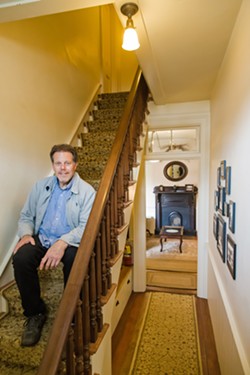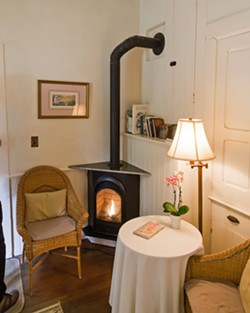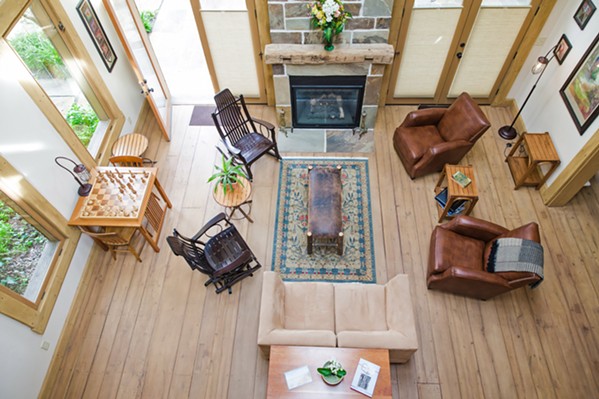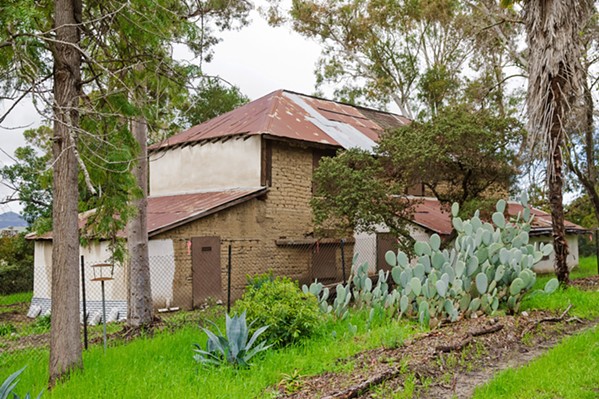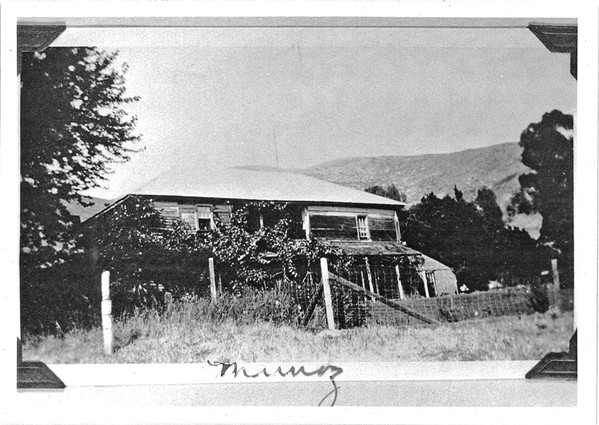Weaving stories : Older buildings from San Luis Obispo County to Santa Maria share tales of the past
By Karen Garcia[{
"name": "Ad - Medium Rectangle CC01 - 300x250",
"id": "AdMediumRectangleCC01300x250",
"class": "inlineCenter",
"insertPoint": "8",
"component": "2963441",
"requiredCountToDisplay": "12"
},{
"name": "Ad - Medium Rectangle LC01 - 300x250",
"id": "AdMediumRectangleCC01300x250",
"class": "inlineCenter",
"insertPoint": "18",
"component": "2963441",
"requiredCountToDisplay": "22"
},{
"name": "Ad - Medium Rectangle LC09 - 300x250",
"id": "AdMediumRectangleLC09300x250",
"class": "inlineCenter",
"insertPoint": "28",
"component": "3252660",
"requiredCountToDisplay": "32"
}]
Burton Drive in Cambria is lined with boutiques, specialty stores, and restaurants for visitors and residents alike to take a moment and shop. Continuing along the street, you might find yourself doing a double take as you approach The Shop Next Door.
The store sits next to the Squibb House and the newly built Black Barn. The house is well known by the local community as one that's been around since the 1800s and is filled with local history from its previous owners. Its current purpose is as a bed and breakfast, but its larger goal is to continue filling the walls with new stories while preserving its past.
Buildings like it can be found across the Central Coast, preserved or restored over the years in order to keep a part of local lore alive. Although several properties are well known and have received a historical landmark certification by the California State Parks, there are others that go unnoticed. Certified landmarks include Mission San Luis Obispo de Tolosa, the Jack House, and Rancho Nipomo, which includes the Dana Adobe.
The Central Coast is home to many other historical buildings, several of which are already repurposed or are on the verge of being revamped to give the surrounding community access to their historical significance.
Weaving in the old with the new
The yellow-and-cream-colored building with green trim has faint painted lettering that says "grain bought and sol." Bruce Black owns the shop and said the missing letter "d" was cut off after the previous owner widened the door when it became an auto repair shop at one point in time.
Now, the shop's purpose is to sell custom-made furniture by Amish craftsmen, local art, and vintage decor pieces.
Black is the fifth owner of the property, which includes The Shop Next Door, the Squibb House, and the Black Barn—all side by side on Burton Street. Black grew up in Pennsylvania, moved to the Bay Area, and eventually wanted to move to the Central Coast. At the time, the Squibb House and its adjoining building, The Shop Next Door, were up for sale. What motivated Black to buy the property in 1993 was its story.
"It's got all this life experience that's walked these floors. You just think, 'Twenty years ago, something was happening in this space,'" Black said. "I think that's the thing that makes it kind of a weave in a tapestry. We're here today as part of a story that winds back through the decades and even the century."
The Squibb House was built in the 1800s, Black said, by Frederick Dark, a Civil War veteran and the principal of the original school in Cambria. The next owners were the Pattersons and their four children. They had a carpentry shop in what is now The Shop Next Door. The Pattersons' son owned the home next with his wife and two daughters, Olma and Bernice.
Black said the sisters visited the Squibb House in 1995—it had been 75 years since they stepped foot in their former home. After that first visit, Black asked Olma to write him letters that described what life and the town were like when they lived there. Through Olma, he learned that the Squibb House was the first in town to have an indoor bathroom. Of course the girls felt like royalty, Black said with a laugh, after having to use an outhouse for years.
"And it's really like time travel because they could talk about this place and this town, you know, 75 or 85 years earlier," he said.
The letters are on display in the hallway of the Squibb House.
The third owner of the home was Van Gordan, a judge who had a rolltop desk in the hallway of the house where the community would come in and pay fines.
The Squibbs, retired educators from Santa Ynez, were the last owners of the house before Black, and they owned the property for about four decades.
Locally the Squibbs were known for a lot of things, but residents like John Seed remember them for keeping the community beautiful.
"We have learned that Squibbing is a local term for picking up trash to beautify the town," Seed said.
Black likes to share these fun facts about the property with the community as well as his guests. As the fifth owner of the property, Black decided to keep the style of the Squibb House intact, fix the leveling of the building, and repurpose the original cabinets of the kitchen.
His contribution to keeping the Squibb House alive, Black said, is turning it into a bed and breakfast a year after he purchased the property in 1994. That way people can continue to add their stories to the house. In the four rooms of the house that individuals and couples can stay, there are notebooks that guests are free to write in, but they aren't your traditional guestbooks, where people write about how clean the sheets were or how lovely their stay was.
"It's almost like a confessional. People always write things down because it's anonymity, and it's more constructive than the internet because it's a hand-written expression of just what you're thinking," he said as he flipped through the pages of one.
The books contain everything from detailed sketches of the house to personal entries of staying at the Squibb House for another anniversary celebration.
Black has also added to the history of the property by building the Black Barn in 2017. It's built from milled wood that traveled to Cambria from his great-great-great-great-grandfather's barn back in his hometown in Pennsylvania.
"That barn was falling down, like many of them are, and the fact of it just being lost to mulch was too sad a prospect, so I had the Amish men in the area help me take it down," he said.
The barn has four additional rooms that guests can book, and it also has a communal lounging area where the complimentary breakfast is served.
Black's goal with the bed and breakfast was to create something that reflected the story of the house and would continue that storytelling tradition. It's an idea that he can relate to because he owns the house where he grew up.
"It's not only the house I grew up in, but that my dad, grandfather, and great-grandfather grew up in. My great-great-grandfather built it," he said. "It really has roots, and I like that it has stories from all of us."
Jane Holton, who worked at the bed and breakfast for years, said the Squibb House added charm to downtown Cambria and had a wonderful soul.
"We starched the napkins and baked fresh cookies for the guests," she said. "I always felt like I was back in time at the turn of the century, with all of the details that surrounded the Victorian home and gardens of the Squibbs."
It's an experience and a history that Holton said she will always treasure.
Starting over
Between houses on Lizzie Street in San Luis Obispo and slightly hidden behind trees and cactus plants is an abandoned building made of mud brick. The La Loma Adobe—also known as La Loma de la Nopalera Adobe, which translates to "sun-dried mud brick house on the hill of prickly pear cactus"—is not much of a sight to see just yet, but it's something that the Friends of La Loma Adobe are currently working on, one project at a time.
Bob Vessely, a civil engineer and a member of the volunteer group, said the neighborhood residents have mixed feelings about the adobe.
"Some of them see this as a godawful eyesore that's reducing property value, and some of them are interested in the history, so they want to know what's going on there," Vessely said.
While the adobe is said to have been built around 1782, Vessely said the group doesn't have a lot of information about the adobe's exact date. What the group does know is that in the 1800s a private San Luis Obispo company purchased about 200 acres of land in the Reservoir Canyon area and constructed several small dams to divert water out of the creek, and a series of pipelines to carry the water to a distribution reservoir just below the canyon.
In 1900, the city of San Luis Obispo purchased the water company in its entirety and became the water purveyor for the community. At the time, the water collection system consisted of several structures on San Luis Obispo Creek, Reservoir Canyon Creek, Hansen Creek, and Gularte Creek; Stenner Creek was a potential site, but a dam was never built.
The La Loma Adobe was on the Stenner Creek property. It's one of four adobes that the city owns and the only two-story adobe. The exact size of the adobe's original property is still a mystery, but the group believes the land was large enough to support a cattle operation. Now the adobe is surrounded by neighborhoods of homes and a baseball field.
Vessely said the owner of the adobe was Dona Maria Concepcion Boronda de Munoz. She first lived in the adobe with her five children, remarried, and then had another five. Vessely said her family expanded, so the house needed to grow as well. Because there is little to no information about the history of the home, the group is speculating that the adobe was originally a one-story structure. He said they can make this observation because the mud bricks on the second story vary in size and shape.
The Friends group has been working with the city to gather funds to restore the structure and to generate public enthusiasm. The primary goal of the group is to get the building stabilized, restored, and used once again.
"I'm firmly convinced that these buildings last if they are used," Vessely said.
The group is currently working on a project to fix the roof of the adobe. Stacked on the top of the roof are wood shingles that leak during the rainy season, and some roof panels are missing entirely.
In order to really kick off the restoration of the adobe, Vessely said the Friends were notified by the city of a cultural community and natural resources grant program. The property qualifies for the grant because the Friends are proposing to keep the land surrounding the adobe open for recreation. As for the building itself, the group is throwing around the idea of using it as a place of residence for park rangers.
"It's a challenge to broaden the interest, but it's important to keep these places because they are a tangible representation of our history and culture, whether you're gringo, came here in the 1950s, or like Maria and her family that came here, or the natives before them. This is where they worked and ate," he said.
While they wait to hear if their project is chosen for the grant funding, Vessely said the Friends will continue to work together a few Fridays a month to do yard work on the adobe's property limits.
In the eye of the beholder
The Smith-Enos House in Santa Maria was visible to Highway 101 commuters for decades. Alexander Posada, director of the city's Recreation and Parks Department, said the land was coming out of agricultural preserve about eight to 10 years ago, and the department took interest in preserving the house.
"It is the last turn-of-the-century farmhouse in Santa Maria. Preserving it is a way to say how the house came to be, you know, it's just another angle of how we can communicate the past," Posada said. "You wouldn't know the history by just driving down the freeway."
The house was moved and now sits on land in between College Drive and Bradley Road. The site is not only the new permanent location for the house, it's also the future site of a park. Posada said the house will be the focal point of Bradley Road with a formal garden area and a barn, all with the goal of creating an event space for gatherings, weddings, and any other occasion.
"We don't have a venue like that here; you go up to San Luis and you have the Jack House, and Arroyo Grande has the little historic park with the Rotary gazebo," he said.
The final layout of the project has been approved by the parks commission; now it's just a matter of moving toward making the concept a reality. The challenge, Posada said, is funding, and the department has the construction drawings and designs on hand for when the funding becomes available.
He said the most important goal of the department is to tell the story of the building that he only knew as the Enos House, at first. Later, through Santa Maria resident Joey Wilson, he learned that an entirely different family constructed the building; it was the Enos family that last lived in it.
Wilson, 86, told New Times that her great-grandfather arrived in Santa Maria around 1769 when the Portola Expedition passed through the Santa Maria Valley during the first Spanish land exploration up the coast. When his diplomatic service was over, he returned to Santa Maria, Wilson said, to raise his family, build a stable for horses, and grow crops. He later uprooted his family and moved to San Diego so he could raise horses there, she said with a laugh, and sold the property.
Wilson's grandmother had family in Bakersfield, so she eventually made her way back to the Santa Maria area.
"I was only in the house once or twice, but I remember it had a beautiful narrow staircase and low ceilings. My grandmother was only 4-foot and 11-inches; my family was small," she said.
Having grown up in Santa Maria, Wilson said she's seen her small agricultural community expand immensely, and for the better.
"We would have to drive for two hours to get to Santa Barbara for specialty shoes because my feet were so narrow, and I couldn't get shoes locally," she said.
Wilson is just glad that the city has taken an interest in her family's home because it does have a huge significance to her—and also the community.
Cindy Ransick, curator of the Santa Maria Valley Historical Society, said that it's a lengthy process to get a property or building certified as having historical merit or designated as a landmark.
In Ransick's opinion, for something to be historical it shouldn't be altered from its original presentation; similar to the way that the past itself shouldn't be altered. While the Smith-Enos House might not have a historical stamp, it has importance within the community.
"That house is in the eye of the beholder. To my knowledge it's one of the last remaining identified historical homes that hasn't been altered, per se, [but] the Enos family did do some renovations," she said. "In terms of hearts and minds, there are a lot of folks who think it is the last opportunity to preserve something in its integrity from that timeline." Δ
Staff Writer Karen Garcia can be reached at [email protected].
Latest in News
Readers also liked…
-

Coast Unified teachers upset over new position's salary and qualifications
Oct 20, 2022 -

SLO police identify alleged driver who hit and killed couple
Dec 22, 2022 -

When the levee breaks: Oceano residents, county officials walk a tightrope of regulations to manage Arroyo Grande Creek, which some say led to the levee's failure in January
May 18, 2023

